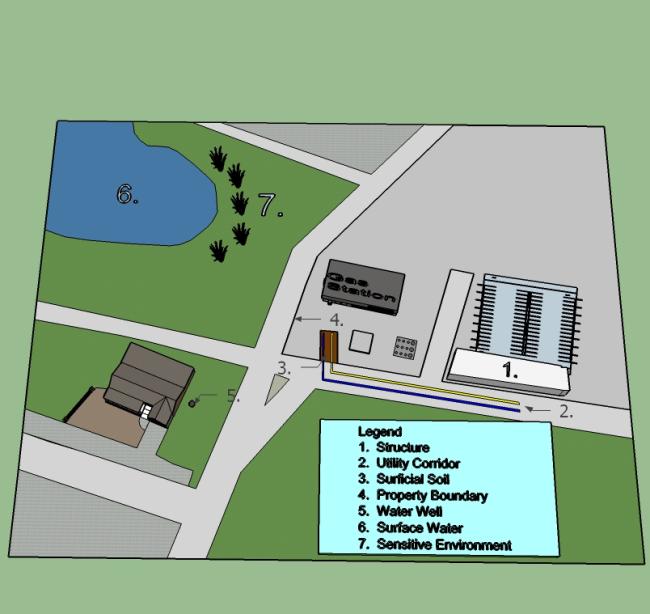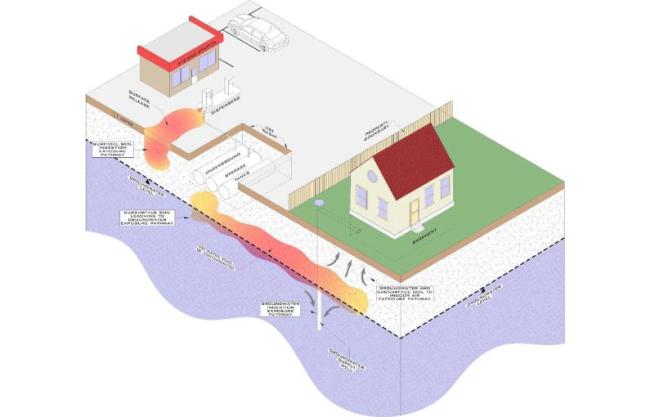Risk Assessment
Releases to the environment may pose a risk to human health and the environment that need to be evaluated when the release occurs. This evaluation includes the identification of POEs ( Point of Exposure) and analysis of exposure pathways.
Click on the arrows below for information about POEs, exposure pathways and risk modeling in association with release events.
POEs for Chemicals of Concern are:
- Property boundaries
- Surficial soils (upper meter of soil)
- Subsurface utilities
- Structures
- Groundwater wells
- Surface water
- Sensitive Environment, which include: critical habitat for federally endangered or threatened species; national parks; national monuments; national recreation areas; national wildlife refuges; national forests; campgrounds; recreational areas; game management areas; wildlife management areas; designated federal wilderness areas; wetlands; wild and scenic rivers; state parks; state wildlife refuges; habitat designated for state endangered species; fishery resources; state-designated natural areas; wellhead protection areas; classified groundwater areas; and county or municipal parks.
POEs for methyl tert-butyl ether are water supply wells and surface water features that are used for human consumption.
All impacted or potentially impacted POEs must be identified during site characterization. Surface water and water wells must be identified within a 2,500 radius from the release during site characterization.
POEs are described and depicted below.
| Point of Exposure | Point of Exposure Description |
| Property boundaries | This is considered to be a POE because neither OPS nor the owner/operator can control activities that could potentially occur beyond the property boundary (e.g., well installation, utility installation or building construction). |
| Surficial soils | All soils located from the ground surface to a depth of one meter below ground surface and are considered POEs to protect a receptor from exposure through dermal contact, inhalation or ingestion. |
| Subsurface utilities | Subsurface utilities are considered POEs to protect a receptor from exposure to vapors in utility corridors. |
| Structures | Structures (with or without a basement) that are not involved in the dispensing of petroleum and are potentially inhabited are considered POEs. |
| Groundwater supply wells | Water supply wells (excluding monitoring wells) are considered POEs. |
| Surface water | Surface waters are considered a POE to protect a person from exposure through dermal contact, ingestion or inhalation. |
| Sensitive environments | Where surface water is present, OPS will treat it as a surface water POE; however, sensitive environments may be subject to more stringent regulation by the agencies directly involved in the management and preservation of these environments (e.g., National Park Service, Colorado Division of Natural Resources, US Army Corps of Engineers or local governments). |
Potential groundwater POEs for release events should be evaluated by using the Colorado Department of Natural Resources' well permits map. Potential surface water POEs should be evaluated by referring to the Colorado Department of Public Health and Environment's Stream Classifications and Water Quality Standards.
An exposure pathway is the path that a contaminant takes from the source of the release to a POE. Each exposure pathway accounts for both the pathway medium (e.g., subsurface soil) and the mode of transport to the POE (e.g., ingestion of groundwater impacted by leachate). All exposure pathways are considered complete (open) until it can be demonstrated that a POE will not be impacted by the release. At that time, the exposure pathway is either considered incomplete or closed/eliminated. The potential for inhalation via vapor intrusion is evaluated by using the Petroleum Vapor Intrusion guidance. If the POE exists within the known or predicted extent of contamination and the exposure pathway is complete, there is a potential risk of exposure.
The exposure pathways are described and depicted below.
| Exposure Pathway | Exposure Pathway Description |
| Groundwater ingestion | This exposure pathway is initially considered complete if groundwater or surface water are impacted above the Tier 1 RBSLs (risk-based screening levels). |
| Groundwater to indoor air | This pathway must be evaluated if groundwater is impacted above the Tier 1 RBSLs and an inhabited structure is present within the influence of hydrocarbon contamination. Structures involved with dispensing petroleum products as part of regular operations are excluded. |
| Surficial - Ingestion, dermal contact, inhalation | This pathway must be considered if soil is impacted above the Tier 1 RBSLs for surficial soil, or above 500 mg/kg for TPHs (total petroleum hydrocarbons), from ground surface to one meter below ground surface. |
| Subsurface Soil to Indoor Air | This pathway must be considered if there are vapor concentrations in soil which exceed the Tier 1 RBSLs for soil contamination volatilizing to indoor air or TPH concentrations in soil greater than 500 mg/kg. Structures involved with dispensing petroleum products as part of regular operations are excluded. |
| Subsurface Soil Leaching to Groundwater | This pathway must be considered if soil contamination is present above Tier 1 RBSLs or above 500 mg/kg TPH at depths greater than one meter. |
Contaminant fate and transport modeling is used to assess the risk to human health and the environment from leaking storage tank sites. It provides a mechanism to predict contaminant concentrations in the future at a POE, such as groundwater supply wells and surface water bodies used for drinking water. Modeling can also be used to establish SSTLs (site-specific target levels). These SSTLs can be used to eliminate an exposure pathway by allowing on-site concentrations greater than the Tier I RBSLs to remain on-site.

